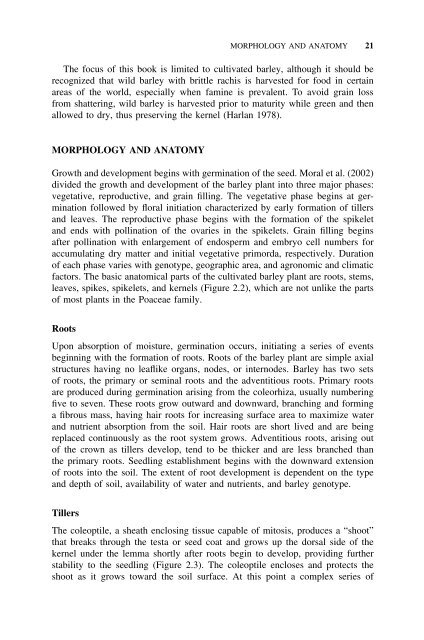Barley for Food and Health: Science, Technology, and Products
Barley for Food and Health: Science, Technology, and Products
Barley for Food and Health: Science, Technology, and Products
Create successful ePaper yourself
Turn your PDF publications into a flip-book with our unique Google optimized e-Paper software.
MORPHOLOGY AND ANATOMY 21<br />
The focus of this book is limited to cultivated barley, although it should be<br />
recognized that wild barley with brittle rachis is harvested <strong>for</strong> food in certain<br />
areas of the world, especially when famine is prevalent. To avoid grain loss<br />
from shattering, wild barley is harvested prior to maturity while green <strong>and</strong> then<br />
allowed to dry, thus preserving the kernel (Harlan 1978).<br />
MORPHOLOGY AND ANATOMY<br />
Growth <strong>and</strong> development begins with germination of the seed. Moral et al. (2002)<br />
divided the growth <strong>and</strong> development of the barley plant into three major phases:<br />
vegetative, reproductive, <strong>and</strong> grain filling. The vegetative phase begins at germination<br />
followed by floral initiation characterized by early <strong>for</strong>mation of tillers<br />
<strong>and</strong> leaves. The reproductive phase begins with the <strong>for</strong>mation of the spikelet<br />
<strong>and</strong> ends with pollination of the ovaries in the spikelets. Grain filling begins<br />
after pollination with enlargement of endosperm <strong>and</strong> embryo cell numbers <strong>for</strong><br />
accumulating dry matter <strong>and</strong> initial vegetative primorda, respectively. Duration<br />
of each phase varies with genotype, geographic area, <strong>and</strong> agronomic <strong>and</strong> climatic<br />
factors. The basic anatomical parts of the cultivated barley plant are roots, stems,<br />
leaves, spikes, spikelets, <strong>and</strong> kernels (Figure 2.2), which are not unlike the parts<br />
of most plants in the Poaceae family.<br />
Roots<br />
Upon absorption of moisture, germination occurs, initiating a series of events<br />
beginning with the <strong>for</strong>mation of roots. Roots of the barley plant are simple axial<br />
structures having no leaflike organs, nodes, or internodes. <strong>Barley</strong> has two sets<br />
of roots, the primary or seminal roots <strong>and</strong> the adventitious roots. Primary roots<br />
are produced during germination arising from the coleorhiza, usually numbering<br />
five to seven. These roots grow outward <strong>and</strong> downward, branching <strong>and</strong> <strong>for</strong>ming<br />
a fibrous mass, having hair roots <strong>for</strong> increasing surface area to maximize water<br />
<strong>and</strong> nutrient absorption from the soil. Hair roots are short lived <strong>and</strong> are being<br />
replaced continuously as the root system grows. Adventitious roots, arising out<br />
of the crown as tillers develop, tend to be thicker <strong>and</strong> are less branched than<br />
the primary roots. Seedling establishment begins with the downward extension<br />
of roots into the soil. The extent of root development is dependent on the type<br />
<strong>and</strong> depth of soil, availability of water <strong>and</strong> nutrients, <strong>and</strong> barley genotype.<br />
Tillers<br />
The coleoptile, a sheath enclosing tissue capable of mitosis, produces a “shoot”<br />
that breaks through the testa or seed coat <strong>and</strong> grows up the dorsal side of the<br />
kernel under the lemma shortly after roots begin to develop, providing further<br />
stability to the seedling (Figure 2.3). The coleoptile encloses <strong>and</strong> protects the<br />
shoot as it grows toward the soil surface. At this point a complex series of

















